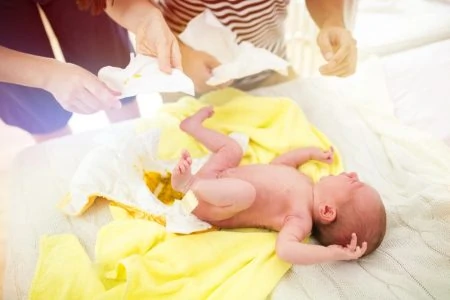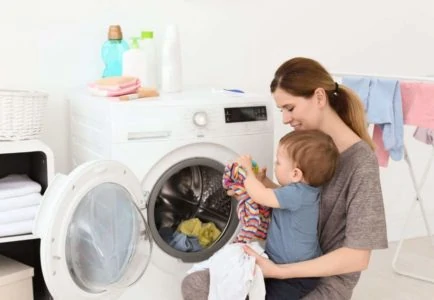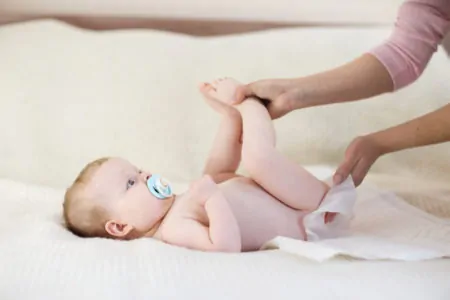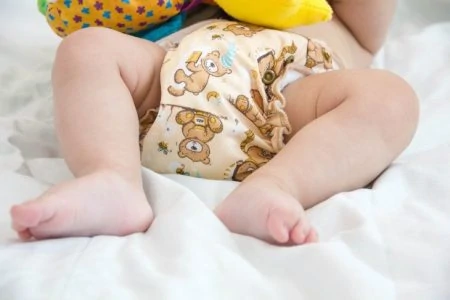You face a beloved onesie covered in a mustard-yellow explosion that reaches the neckline. We have all been there.
It looks like a lost cause, but don’t toss that outfit in the trash just yet.
We have dealt with more blowouts than we care to admit, and we have tested every cleaning hack to find what actually works. It is entirely possible to save your baby clothes, cloth diapers, and even your carpet from permanent damage.
Here is the ultimate guide to removing poop stains using safe, effective methods that actually work.
Key Takeaways
- Act fast: Rinse the stained item with cold water immediately to stop the poop from setting into the fibers.
- Treat the spot: Use effective stain removers like OxiClean, lemon juice, or a DIY mix of hydrogen peroxide and Dawn dish soap.
- Skip the dryer: Never put a stained item in a hot dryer until the mark is completely gone, as heat locks stains in forever.
- Prevent future messes: Use fleece liners inside diapers to catch solids and protect the fabric underneath.
How To Stop Poop Stains Before They Start
Prevention is always easier than scrubbing. Cloth diapers often contain messes better than disposables thanks to their strong back elastic, but even disposable diapers can benefit from a reusable cover to catch leaks.
If you want to save yourself from scrubbing clothes or washing the baby in the bathtub after every change, try using liners.
You can cut up a fleece blanket into small rectangles to lay inside the diaper. Fleece allows moisture to pass through to the absorbent layers while catching the solids on top. Because poop does not stick to fleece easily, you can shake it right into the toilet.
You can buy cheap fleece blankets at most dollar stores. One throw blanket yields about 30 liners, making this a budget-friendly hack.
Some parents use paper towels, but fleece is sturdier and keeps the baby’s skin drier. Plus, fleece liners can be washed and reused hundreds of times.
How To Remove Poop Stains From Clothes And Carpet
Sometimes a blowout happens despite your best efforts. If you live in a sunny area, UV rays are a natural bleaching agent (1). However, if it is winter or you lack outdoor space, you need a chemical assist.
Follow these steps to rescue your fabrics.
1. Rinse Away The Excess
Time is your enemy here. Remove solids immediately. If you are using cloth diapers, a cloth diaper sprayer attached to your toilet is a game-changer. For carpets, lift the solid waste straight up with a paper towel or gloved hand to avoid pushing it deeper into the fibers.
Pro Tip: Always rinse with cold water first. Hot water can “cook” the proteins in the poop, bonding them to the fabric instantly.
2. Soak The Fabric
Once the solids are gone, soak the item in warm water to loosen the fibers. If you are treating carpet or upholstery, saturate the spot using a spray bottle.
3. Choose Your Stain Fighter
We have tested dozens of products to see which ones actually lift organic stains. Whether you prefer natural solutions or heavy-duty chemicals, here are the best options to help you make an informed buying decision.
Natural Stain Removers
- Buncha Farmers Stain Stick: This stick is made with coconut and vegetable oils. You can rub it directly on the wet stain, or grate a little bit into a spray bottle with hot water to create a liquid pre-treater.
- Lemon Juice: The citric acid breaks down bonds in the stain. Squirt fresh lemon juice on the wet spot or mix a 1:4 ratio of juice to water in a spray bottle. This works best when combined with sunlight.
Synthetic Stain Removers
- OxiClean White Revive: This is an oxygen-based bleach alternative that is safe for colors. Make a paste or pour a small amount directly onto the stain before washing.
- Shout Stain Remover: This classic spray relies on enzymes to eat away at organic matter. Spray it on and let it work its magic for a few minutes before washing.
The “Magic” Homemade Solution
- The DIY Power Trio: If you are out of store-bought sprays, mix one part Dawn dish soap, one part baking soda, and two parts hydrogen peroxide. Apply this paste to the stain and watch it bubble up as it lifts the mess.
4. Scrub And Wait
Agitation is key. Use an old toothbrush or a laundry brush to work the cleaning solution deep into the fibers. Do not just spray and pray; you need to scrub. Let the solution sit on the fabric for 15 to 20 minutes to break down the proteins.
5. Wash As Usual
Toss the item into the wash with a high-quality baby laundry detergent. If you are washing cloth diapers, use your standard routine.
For carpets, spray the area with cool clean water to rinse out the soap, then blot it dry with a clean white towel until no moisture remains.
6. The Golden Rule: Check Before Drying
Never put a stained item in the dryer. If the stain is still visible, the high heat of the dryer will set it permanently. If the stain remains after washing, repeat the treatment process or try sun drying.
Hang wet items in direct sunlight. UV rays destroy bilirubin (the yellow pigment in poop). This works even on cloudy days, though it might take longer.
A Note On Cloth Diaper Safety
If you are treating cloth diapers, you must be careful about which products you use. Oil-based soaps or fabric softeners can coat the fibers, causing the diaper to repel pee instead of absorbing it.
Fortunately, the stain removers listed above are generally safe for cloth diapers if rinsed thoroughly. Always double-check ingredient lists against a reputable cloth diaper detergent index (2) to ensure you are not voiding your warranty.







